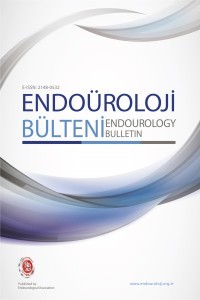T1a/T1b Evre Renal Tümörlerde Laparoskopik Parsiyel Nefrektomi: Biz Neredeyiz?
laparoskopik parsiyel nefrektomi, minimal invaziv cerrahi, böbrek tümörü
Laparoscopic Partial Nephrectomy in T1a/T1b Stage Renal Tumors: Where We Are?
___
- 1. Ljungberg B, Albiges L, Abu-Ghanem, Y, et al. European association of urology guidelines on renal cell carcinoma: the 2019 update. European urology, 2019; 75(5): 799-810.
- 2. Campbell S, Uzzo RG, Allaf ME, et al. Renal mass and localized renal cancer: AUA guideline. J Urol 2017 Sep;198(3):520-9.
- 3. Maurice MJ, Zhu H, Kim SP, Abouassaly R. Increased use of partial nephrectomy to treat high-risk disease. BJU Int 2016 Jun;117(6B):E75-86.
- 4. Carneiro A, Sivaraman A, Sanchez‐Salas R et al. Evolution from laparoscopic to robotic nephron sparing surgery: a high‐volume laparoscopic center experience on achieving “trifecta” outcomes. World J Urol 2015; 33: 2039–44.
- 5. Khalifeh A, Autorino R, Hillyer SP et al. Comparative outcomes and assessment of trifecta in 500 robotic and laparoscopic partial nephrectomy cases: a single surgeon experience. J Urol 2013; 189: 1236–42.
- 6. Thompson RH, Lane BR, Lohse CM, et al. Every minute counts when the renal hilum is clamped during partial nephrectomy. Eur Urol 2010;58(3):340–345.
- 7. Yu HY, Hevelone ND, Lipsitz SR, Kowalczyk KJ, Hu JC. Use, costs and comparative effectiveness of robotic assisted, laparoscopic and open urological surgery. J Urol 2012;187:1392–1398.
- 8. Kutikov A, Uzzo RG. The R.E.N.A.L. Nephrometry Score: A comprehensive standardized system for quantitating renal tumor size, location and depth. J Urol 2009;182:844-53.
- 9. Dindo D, Demartines N, Clavien PA. Classification of surgical complications: A new proposal with evaluation in a cohort of 6336 patients and results of a survey. Ann Surg 2004;240:205-13.
- 10. Levey AS, Bosch JP, Lewis JB, Greene T, Rogers N, Roth D. A more accurate method to estimate glomerular filtration rate from serum creatinine: a new prediction equation. Modification of Diet in Renal Disease Study Group. Ann Intern Med 1999;130(6):461-70.
- 11. Go AS, Chertow GM, Fan D, McCullochCE, HsuCY. Chronic kidney disease and the risks of death, cardiovascular events, and hospitalization. N Engl J Med 2004;351:1296–1305.
- 12. Klatte T, Shariat SF, Remzi M. Systematic review and meta-analysis of perioperative and oncologic outcomes of laparoscopic cryoablation versus laparoscopic partial nephrectomy for the treatment of small renal tumors. J. Urol 2014;191(5):1209e1217.
- 13. Hyams E, Pierorazio P, Mullins JK, et al. A comparative cost analysis of robot-assisted versus traditional laparoscopic partial nephrectomy. J. Endourol 2012;26 (7): 843e847.
- 14. Ng AM, Shah PH, Kavoussi LR. Laparoscopic partial nephrectomy: A narrative review and comparison with open and robotic partial nephrectomy. Journal of endourology 2017;31(10): 976-984.
- 15. Marszalek M, Meixl H, Polajnar M, Rauchenwald M, Jeschke K, Madersbacher S. Laparoscopic and open partial nephrectomy: a matched-pair comparison of 200 patients. European urology 2009; 55(5): 1171-1178.
- 16. Kızılay F, Turna B, Apaydın E, Semerci B. Comparison of long‐term outcomes of laparoscopic and robot‐assisted laparoscopic partial nephrectomy. The Kaohsiung journal of medical sciences, 2019; 35(4): 238-243.
- 17. Mehra K, Manikandan R, Dorairajan LN, Sreerag S, Jain A, Bokka SH. Trifecta Outcomes in Open, Laparoscopy or Robotic Partial Nephrectomy: Does the Surgical Approach Matter?. Journal of kidney cancer and VHL 2019;6(1): 8-12.
- 18. Xu H, Ding Q, Jiang HW. Fewer complications after laparoscopic nephrectomy as compared to the open procedure with the modified Clavien classification system—a retrospective analysis from southern China. World J Surg Oncol 2014;12:242.
- 19. Shiroki, R., Fukami, N., Fukaya, K. Et al. Robot‐assisted partial nephrectomy: Superiority over laparoscopic partial nephrectomy. International Journal of Urology 2016;23(2): 122-131.
- 20. Gong EM, Orvieto MA, Zorn KC, Lucioni A, Steinberg GD, Shalhav AL. Comparison of laparoscopic and open partial nephrectomy in clinical T1a renal tumors. J. Endourol 2008; 22: 953–7.
- 21. Gill IS, Kamoi K, Aron M, Desai MM. 800 Laparoscopic partial nephrectomies: a single surgeon series. The Journal of urology 2010; 183(1): 34-42.
- 22. Wang AJ, Bhayani SB. Robotic partial nephrectomy versus laparoscopic partial nephrectomy for renal cell carcinoma: single-surgeon analysis of> 100 consecutive procedures. Urology 2009;73(2): 306-310.
- 23. Pavan N, Derweesh IH, Mir CM, et al. Outcomes of laparoscopic and robotic partial nephrectomy for large (> 4 cm) kidney tumors: systematic review and meta-analysis. Annals of surgical oncology 2017; 24(8): 2420-2428.
- 24. Benway BM, Bhayani SB, Rogers CG et al. Robot assisted partial nephrectomy versus laparoscopic partial nephrectomy for renal tumors: a multi-institutional analysis of perioperative outcomes. J. Urol 2009; 182: 866–72.
- 25. Kural AR, Atug F, Tufek I, Akpinar H. Robot-assisted partial nephrectomy versus laparoscopic partial nephrectomy: comparison of outcomes. Journal of endourology, 2009;23(9):1491-1497.
- 26. Tachibana H, Takagi T, Kondo T, Ishida H, Tanabe K. Robot‐assisted laparoscopic partial nephrectomy versus laparoscopic partial nephrectomy: A propensity score‐matched comparative analysis of surgical outcomes and preserved renal parenchymal volume. International Journal of Urology 2018;25(4):359-364.
- 27. Boga MS and Sönmez MG. "Long-term renal function following zero ischemia partial nephrectomy." Research and reports in urology 2019;11: 43.
- Yayın Aralığı: Yılda 3 Sayı
- Başlangıç: 2020
- Yayıncı: ENDOÜROLOJİ DERNEĞİ
Robot Yardımlı Laparoskopik Retroperitoneal Parsiyel Nefrektomi
Mahmut Taha ÖLÇÜCÜ, Kayhan YILMAZ, Mutlu ATEŞ
Yazılım Destekli Manyetik Rezonans Ultrason Füzyon Biyopsi Tekniklerine Güncel Bakış
Selahattin BEDİR, Engin KAYA, Serdar YALÇIN, Murat ZOR
Mustafa BOZ, Vahit GÜZELBURÇ, Gökhan ÇALIK, Mustafa SOYTAŞ, Çağrı KAÇTAN, Selçuk GÜVEN
Mustafa Bilal TUNA, Tünkut DOĞANCA, İlter TÜFEK, Can ÖBEK, Ali Rıza KURAL
Dünden Bugüne Radikal Perineal Prostatektomi: Açık, Perineoskopik, Robotik
Yusuf İlker ÇÖMEZ, Doğukan SÖKMEN, Volkan TUĞCU
Prostat Kanseri Tedavisinde Fokal Tedaviler
Mesane Tümörünü Taklit Eden İntravesikal Yabancı Cisim: Nadir Bir Olgu Sunumu
Engin KAYA, Nejdet KARŞIYAKALI, Selçuk SARIKAYA, Sinan AKAY, Turgay EBİLOĞLU, Murat ZOR, Selahattin BEDİR
Bir Bakışta Üriner Sistem Taş Hastalığına Metabolik Yaklaşım
Prostat Enükleasyonunda Lazer Savaşları : Holmium vs Thulium Lazer
Mehmet YILMAZ, Engin KAYA, Eymen GAZEL, Serdar YALÇIN, Sercan YILMAZ, Halil Çağrı AYBAL, Lütfi TUNÇ
T1a/T1b Evre Renal Tümörlerde Laparoskopik Parsiyel Nefrektomi: Biz Neredeyiz?
Mehmet Salih BOĞA, Murat SAVAŞ, Mahmut Ekrem İSLAMOĞLU, Mehmet Giray SÖNMEZ, Kayhan YILMAZ, Mahmut Taha ÖLÇÜCÜ, Kaan KIRAMIK, Çağatay ÖZSOY, Mutlu ATEŞ
